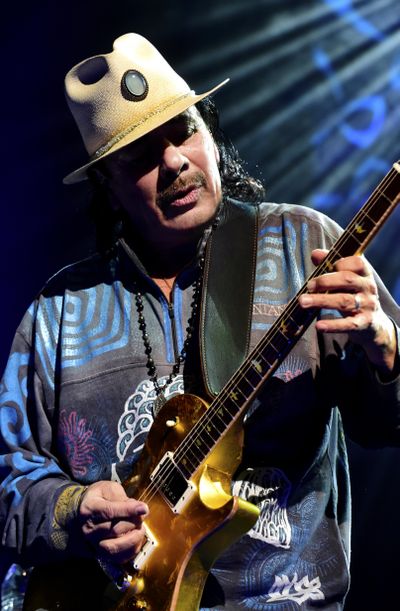Spirituality guides Carlos Santana on and off stage

At least once a week, sometimes multiple times a day, world-renowned musician Carlos Santana posts on his official Facebook page (6.4 million likes and counting).
Sometimes, like on Jan. 21, these posts are short and sweet.
“War starts with the letter W/Because it is Weak/Peace starts with the letter P/Because it is Powerful.”
Other times, they’re lengthier, like when he waxes poetic about the importance of choosing “thoughts of divine intent” or proposes new film ratings, “HC,” for “High Consciousness,” and “LC,” for “Low Consciousness,” with the suggestion that the recently released “Black Panther” be rated “HC.”
More often than not, these posts are translated into Santana’s native Spanish too.
Santana – the man and the band – has always had a spiritual quality about it.
Sure, there was the time Santana, famously or infamously, performed the band’s breakthrough set at Woodstock under the influence of the psychedelic drug mescaline.
“It was the most exploratory decade,” Santana said about the ’60s in a 2015 interview with Las Vegas magazine. “People were accessing the intangibles, the invisible worlds. People today have computers to do all kinds of things, and they’ve eliminated the most important quality in the human being, which is imagination.”
And yes, a few years after the 1969 release of the band’s self-titled debut album, English guitarist and bandleader John McLaughlin introduced Santana to spiritual leader Sri Chinmoy, who often spoke about obtaining spiritual progress through love, devotion and surrender.
In 1973, Santana and McLaughlin released an album inspired by Chinmoy’s teachings, also called “Love Devotion Surrender,” that found Santana trading the rock music he was known for for jazz fusion.
The following year, Santana collaborated with Alice Coltrane on “Illuminations,” which he released as Devadip Carlos Santana, using the Sanskrit name Chinmoy gave him.
He released two solo albums – “Oneness: Silver Dreams - Golden Reality” and “The Swing of Delight” – as Devadip Carlos Santana in 1979 and 1980, respectively.
Santana ended his relationship with Chinmoy in 1982, but he doesn’t regret the experience.
“I’m really grateful for those 10 years I spent with that spiritual master,” Santana told Rolling Stone in 2017. “I don’t believe I will be lost in the evil ocean, because what I learned was very much like a West Point discipline, like a Marine. ”
But the real spiritual nature of Santana – again, the man and the band – is in the music.
It’s obvious when considering album titles like “Spirits Dancing in the Flesh,” “Supernatural” and “Shaman.”
“Supernatural,” the band’s 17th studio album, featured the chart-topping singles “Smooth” featuring Matchbox Twenty’s Rob Thomas and “Maria Maria” featuring the Product G&B.
The album, which was released in 1999, eventually went 15 times platinum in America and won eight Grammys, including album of the year, and three Latin Grammys, including record of the year for the song “Corazón Espinado.”
The band’s follow up album, “Shaman,” included the single “The Game of Love” featuring Michelle Branch, which won the Grammy for best pop collaboration with vocals in 2002.
But it’s when the band is onstage that you get the sense something otherworldly is happening.
The band, and especially the frontman himself, performs as if the music is flowing through them, like they’re channeling the notes from some higher power.
Often when performing, Santana seems to simply close his eyes and let that higher power guide his fingers across the guitar.
“Don’t think so much before you play,” he told Rolling Stone in 2000. “Just let it flow… That’s the best kind of music, when you go beyond gravity and time and thinking. Not many mortals do it. I am just trying to get there. Every night I’m trying to get there, man.”
Santana will perform at the Spokane Arena on Sunday as part of the band’s “Divination” tour.
“Divination - ‘To foresee and be inspired by God’ ” Santana captioned a Facebook photo about the tour in January.
The “Divination” tour follows the 2017 release of “Power of Peace,” a collaborative album with the Isley Brothers, and the 2016 release of “Santana IV,” which found most of the band’s Woodstock-era lineup – Santana, Gregg Rolie, Neal Schon, Michael Carabello and Michael Shrieve – reuniting after decades apart.
“It was magical,” Santana said on his website when announcing the “Santana IV” preorder. “We didn’t have to try to force the vibe. It was immense.”
After debuting at No. 5 on the Billboard 200, “Santana IV” became the band’s 14th album to reach the top 10 album on the chart.
On and off stage, spirituality has played a role in Santana’s life, but it’s when he combines the two that the powers of both are magnified.
“Music gives a spiritual sense of order to the molecules in your brain and your lungs and your heart,” he told Las Vegas magazine in 2015. “Music reminds you of the forgotten song inside you.”